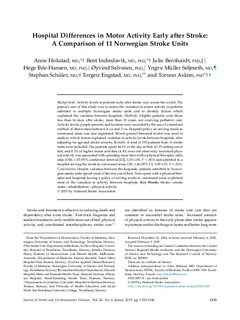| dc.description.abstract | Background:Activity levels in patients early after stroke vary across the world. The
primary aim of this study was to assess the variation in motor activity in patients
admitted to multiple Norwegian stroke units and to identify factors which
explained the variation between hospitals.Methods:Eligible patients were those
less than 14 days after stroke, more than 18 years, not receiving palliative care.
Activity levels, people present, and location were recorded by the use of a standard
method of observation between 8AMand 5PM. Hospital policy on serving meals in
communal areas was also registered. Mixed general binomial model was used to
analyze, which factors explained variation in activity levels between hospitals, after
adjusting for age and stroke severity.Results:A total of 393 patients from 11 stroke
units were included. The patients spent 44.1% of the day in bed, 43.2% sitting out of
bed, and 8.3% in higher motor activities (4.4% were not observed). Increased physical activity was associated with spending more time with a physical therapist, odds
ratio (OR), 1.05 (95% confidence interval [CI], 1.03-1.08,P,.001) and admitted to a
hospital serving the meals in communal areas, OR, 1.46 (95% CI, 1.09-1.95,P5.011).
Conclusions:Despite variation between the hospitals, patients admitted to Norwegian stroke units spend most of the day out of bed. Time spent with a physical therapist and hospitals having a policy of serving meals in communal areas explained
most of the variation in activity between hospitals. | nb_NO |
